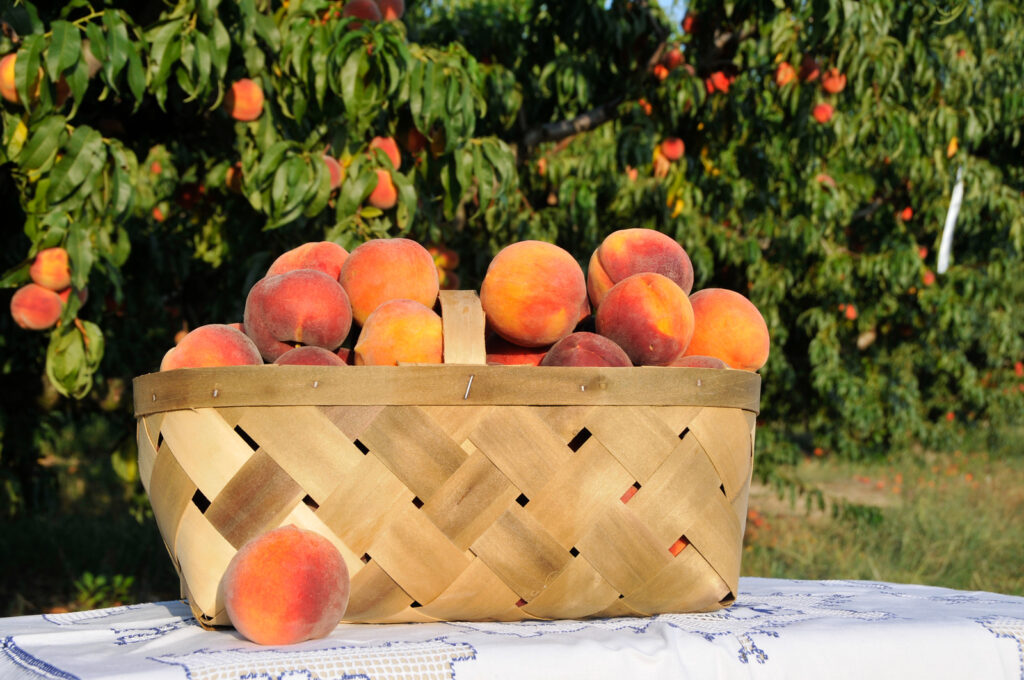Anna Sara Hill, Horticulture Extension Agent
A tasty fruit synonymous with summertime in the Southeastern United States, is the peach. In fact, August is National Peach Month. Whether eaten fresh, or in a dessert such as a cobbler or ice cream the delicious flavor of South Carolina’s state fruit is as “peachy keen” as the peaches cultivated history of production 🍑.
Origins in China
The story begins in China where the fruit originated. Peaches are endemic to China, but the exact epicenter is unknown. The Chinese have been domesticating peaches for so many millennia that according to the Flora and Fauna of China wild type peaches do not exist.
Archaeological evidence shows peaches were domesticated in China’s lower Yangzi River Valley around 8,000-7,000 BC, with cultivation spreading to Japan by 6400 BC. Peach stones recovered in archaeological digs indicate that diverse groups over a broad geographic region of China were cultivating and selecting peaches for preferred traits by 8,000-7,000 BC.
Global Spread
From China, peaches were spread to India (126 BC), and the Mediterranean (first century) through trade routes. The Romans introduced them to Italy and other parts of their vast empire. Gradually they were spread throughout Western Europe and eventually found their way to North America.
American Introduction
Spanish conquistadors brought peaches to Mexico in 1571, with the first U.S. plantings by Spanish monks on St. Simons Island. However, Native Americans were instrumental in spreading peaches throughout the Southeast, quickly adopting and breeding the fruit by the early 16th century. By 1620, European settlers reported vast peach groves with more varieties than in Europe.
The Native Americans quickly adopted the fruit and were selecting and breeding peaches by the early 16’th century. They spread them across the southeast and into the interior. Archeological findings to date show peach groves were planted at the Muskogee Farm in Oconee Valley Georgia between 1520-1550. This predates the settlement of St. Augustine.
Records from European settlers dating to 1620 indicate that there were vast peach groves and that the number of varieties in North America outnumbered European varieties. Approximately 100 years after the founding of Saint Augustine there were accounts of dense wild stands of peach trees in the southeast from Charleston north to New York and into the southeastern interior (Tennessee and Alabama). One report from the 17’th century describes the trees as “weeds” in the southern colonies.

Commercial Development
The Southeast became America’s peach center in the mid-1800s. Samuel L. Rumph developed the famous Elberta variety in Georgia, naming it after his wife. Released commercially in 1881, it became the most widely produced peach in the United States. Georgia earned its nickname “the Peach State” as peach production replaced cotton after the Civil War.
The piedmont and the ridge of SC are well suited for flavorful peach production because of the warm humid air, and slightly acidic soil. As a result, SC eventually surpassed Ga in peach production. On the ridge the cool air sinks into the valleys giving the peaches that sweet flavor that earned SC it’s nickname of the “tastier fruit state”.
Early producers, William Henry Ravenel who made the first commercial peach shipment out of the state of SC from his plantation near Aiken (1859). and Jame H. Verne a pioneer commercial peach grower in the piedmont. Another major player was the first commissioner of Agriculture, Colonel R. B. Watson from Edgefield SC. who convinced six large asparagus growers to plant 20 acres of 3 varieties each for a total of 60 acres per grower. The investment paid off and peach production boomed in SC. Today the majority of SC commercial peach acreage is on the ridge.
Modern Production
Today, California leads U.S. peach production with 525,990 tons in 2024 (96% of processed peaches and 50% of fresh market), followed by South Carolina with 84,630 tons. China remains the top producer globally, while Japan, Greece, and the U.S. produce the world’s sweetest peaches.
Commercial peach production remains labor-intensive, with grafting, planting, pruning, and harvesting still manually using methods unchanged for centuries. The cultivation story continues as growers work to develop improved varieties and maintain commercial viability.
Clemson University Cooperative Extension Service offers its programs to people of all ages, regardless of race, color, gender, religion, national origin, disability, political beliefs, sexual orientation, gender identity, marital or family status and is an equal opportunity employer.
